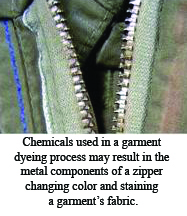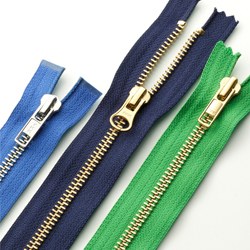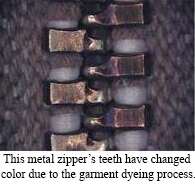 During a garment dyeing process, different types of dyestuff and auxiliaries are used depending on the nature of the garment fabric. For example, a sulfur dye, reactive dye or a direct dye is usually used for cotton fabrics, while an acid dye is used for dying nylon products. Moreover, the usage of various chemicals such as reducing agents, oxidizing agents, acids and alkalis is rather common.
During a garment dyeing process, different types of dyestuff and auxiliaries are used depending on the nature of the garment fabric. For example, a sulfur dye, reactive dye or a direct dye is usually used for cotton fabrics, while an acid dye is used for dying nylon products. Moreover, the usage of various chemicals such as reducing agents, oxidizing agents, acids and alkalis is rather common.
When there is an abundance of dyestuff and chemicals in a garment dyeing process, this may result in the metal components of a zipper changing color and staining a garment.
A chemical reaction may take place when a zipper’s metal components, including the elements, slider, top stops, bottom stop and open parts, come into contact with different chemicals. This change in color may result in staining a garment. In addition, the chemicals in the dyestuff may react with the metal components of a zipper and result in a bleaching or discoloration of the fabrics. The change in the fabric color may vary from time to time depending on but not limited to the following factors:
- The nature and concentration of the dyestuff/chemicals used
- The processing temperature during the garment dyeing treatment
- The length of the processing time
- The garment’s stain resistance
Very often, the change in the fabric color will be further accelerated when the garment’s zippers are pressed against the garment when it is wet or left in a humid environment for a long time.
Due to the properties of metal, a chemical reaction is difficult to avoid when metal zippers are subjected to the garment dyeing process. For this reason, we recommend sewing the zippers into a garment after the dyeing process. Also, a garment should be thoroughly neutralized, rinsed and dried immediately after the dyeing process to prevent any dyestuff or chemical residue from reacting with a zipper.
If zippers must be subjected to the garment dyeing process, we recommend doing a pre-production test on the reaction of the zippers in order to prevent any undesirable effect on both the zippers and the garment.


